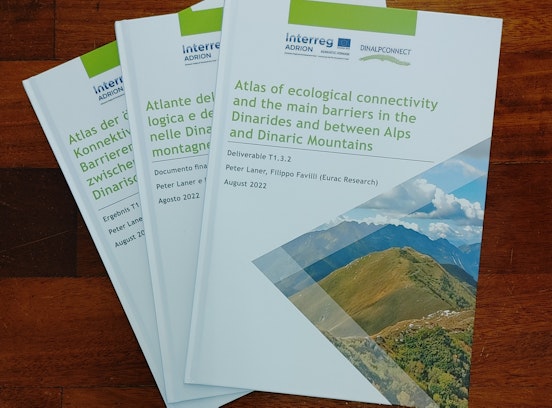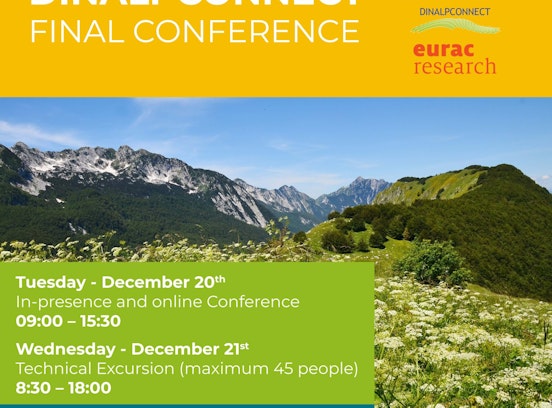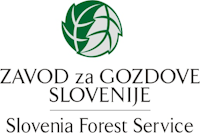Institute for Regional Development - Projects - DINALPCONNECT
DINALPCONNECT
Transboundary ecological connectivity of Alps and Dinaric Mountains
- Deutsch
- English
- Italiano
- Project duration: -
- Project status: finished
- Funding: Other EU Funding (EU funding / Project)
- Total project budget: €1,620,972.00
- Website: https://dinalpconnect.adrioninterreg.eu/
- Institute: Institute for Regional Development
Ecological connectivity helps counteracting negative effects of habitat fragmentation and climate change. Eleven partners from seven countries will work to strengthen transnational cooperation to improve ecological connectivity throughout Dinaric Mountains connecting them with the Alps. EU and national policies will be examined, together with a socio-economic perspective of current pro-biodiversity businesses in the Pilot Regions, to prepare guidelines for their development in the project area. GIS spatial data will be collected to analyse the current ecological network and barriers. Combining analytical results with expert knowledge will deliver a Strategy for ecological connectivity throughout Dinaric Mountains connecting them with the Alps, which will be adopted by policy makers.
DINALPCONNECT project aims at improving transnational cooperation to reduce fragmentation and improve ecological connectivity for long-term conservation of biodiversity and delivery of ecosystem services in the project area. Balkan peninsula acted as ice age refugia and played a crucial role for re-colonisation of Central and Northern Europe by plant and animal species. Some of Europe’s largest well-preserved old growth forests are found in Dinaric mountains. However, this is threatened by habitat fragmentation and habitat loss due to a range of pressures associated with agriculture and forestry. Un-coordinated development of infrastructure and urbanisation further fragment natural habitats and reduce long-term resilience of ecosystems and their services. Therefore, a conceptual framework is needed which would coordinate development to maintain ecological connectivity and identify priority areas for implementation of green infrastructure at different governance levels. A DINALPCONNECT strategy for ecological connectivity in Dinaric Mountains and connectivity with the Alps based on spatial analysis of current corridors and barriers will provide such a framework at the macro-regional level. On a transboundary level, Pilot region Action plans based on guidelines for agricultural and forestry practices protecting biodiversity will enable implementation of actions for improved EC of selected priority habitats on both sides of the national border.
Favilli F (2023)
Presentation/Speech
Conference: Wildlife and Roads| Multiple aspects of an issue LIFE SAFE-CROSSING Final Conference | Sulmona : 17.5.2023 - 18.5.2023
Favilli F, Laner P. (2023)
Presentation/Speech
Conference: Wildlife and Roads| Multiple aspects of an issue LIFE SAFE-CROSSING Final Conference | Sulmona : 17.5.2023 - 18.5.2023
More information: https://life.safe-crossing.eu/
Favilli F, Laner P, Bertoncelj I (2023)
Journal article
Biodiversity and Conservation
More information: https://link.springer.com/article/10.1007/s10531-023-02651-6
Favilli F (2022)
Presentation/Speech
Conference: Human & wildlife co-existence – traditional & modern farming approaches in the mountains | Sighisoara | 11.7.2022 - 13.7.2022
Laner P, Favilli F (2022)
Presentation/Speech
Conference: Securing ecological connectivity for large carnivores in the Carpathians | Baia Mare, Maramures | 4.7.2022 - 7.7.2022
More information: https://openbordersforbears.com/en/
Favilli F, Laner P (2022)
Presentation/Speech
Conference: Large Carnivores, Wild Ungulates and Society Platform - WISO. 3rd meeting in the mandate until the XVII alpine conference | Online | 15.2.2022 - 15.2.2022
Omizzolo A, Laner P, Favilli F (2022)
Presentation/Speech
Conference: 61st ERSA Annual Congress | Pécs | 22.8.2022 - 27.8.2022
Favilli F, Laner P (2022)
Presentation/Speech
Conference: Large Carnivores, Wild Ungulates and Society Platform - WISO. 3rd meeting in the mandate until the XVII alpine conference | Online | 15.2.2022 - 15.2.2022
Laner P, Favilli F (2022)
Dinalpconnect.adrioninterreg.eu
(Valorisation of agricultural and forested landscapes for ecological connectivity potential)
Report
More information: https://dinalpconnect.adrioninterreg.eu/wp-content/uploads/2 ...
Laner P (2022)
Presentation/Speech
Conference: 4th International Conference on "Smart and Sustainable Planning for Cities and Regions - SSPCR 2022" | Bolzano/Bozen | 19.7.2022 - 22.7.2022
Laner P, Favilli F (2022)
EU Interreg Adrion DINALPCONNECT project
(Valorisation of agricultural and forested landscapes for ecological connectivity potential)
Report
More information: https://dinalpconnect.adrioninterreg.eu/wp-content/uploads/2 ...
Laner P, Favilli F (2022)
Presentation/Speech
Conference: DINALPCONNECT Conference on Ecological Connectivity | Velenje | 6.6.2022 - 7.6.2022
More information: http://dacconference.si/book_of_abstracts/
Laner P, Favilli F (2022)
(Valorisation of agricultural and forested landscapes for ecological connectivity potential)
Report
More information: https://dinalpconnect.adrioninterreg.eu/wp-content/uploads/2 ...
Mezzena D, Favilli F, Laner P (2022)
Internet
More information: https://www.eurac.edu/en/magazine/homo-sano-in-natura-sana
Favilli F, Laner P (2022)
Presentation/Speech
Conference: IENE 2022 International Conference “Connecting people, connecting landscapes” | Cluj Napoca | 19.9.2022 - 23.9.2022
Kostelić B, Grgić M, Novoselc J, Favilli F (2022)
EU Interreg Adrion DINALPCONNECT project
(Develop Action plans for Pilot regions to promote ecological connectivity on transboundary level)
Report
More information: https://dinalpconnect.adrioninterreg.eu/wp-content/uploads/2 ...
Pretner M, Ferfolja S, Favilli F (2022)
EU Interreg Adrion DINALPCONNECT project
(Develop Action plans for Pilot regions to promote ecological connectivity on transboundary level)
Report
More information: https://dinalpconnect.adrioninterreg.eu/wp-content/uploads/2 ...
Leonetti L, Boshnjaku A, Travlos I, Antonopoulos N, Gazoulis I, Favilli F (2022)
EU Interreg Adrion DINALPCONNECT project
(Develop Action plans for Pilot regions to promote ecological connectivity on transboundary level)
Report
More information: https://dinalpconnect.adrioninterreg.eu/wp-content/uploads/2 ...
Bilaver Galinec E, Premelč M, Favilli F (2022)
EU Interreg Adrion DINALPCONNECT project
(Develop Action plans for Pilot regions to promote ecological connectivity on transboundary level)
Report
More information: https://dinalpconnect.adrioninterreg.eu/wp-content/uploads/2 ...
Laner P, Favilli F (2022)
Presentation/Speech
Conference: SaveGREEN - final conference | Vienna | 6.12.2022 - 7.12.2022
More information: https://www.interreg-danube.eu/approved-projects/savegreen/s ...


